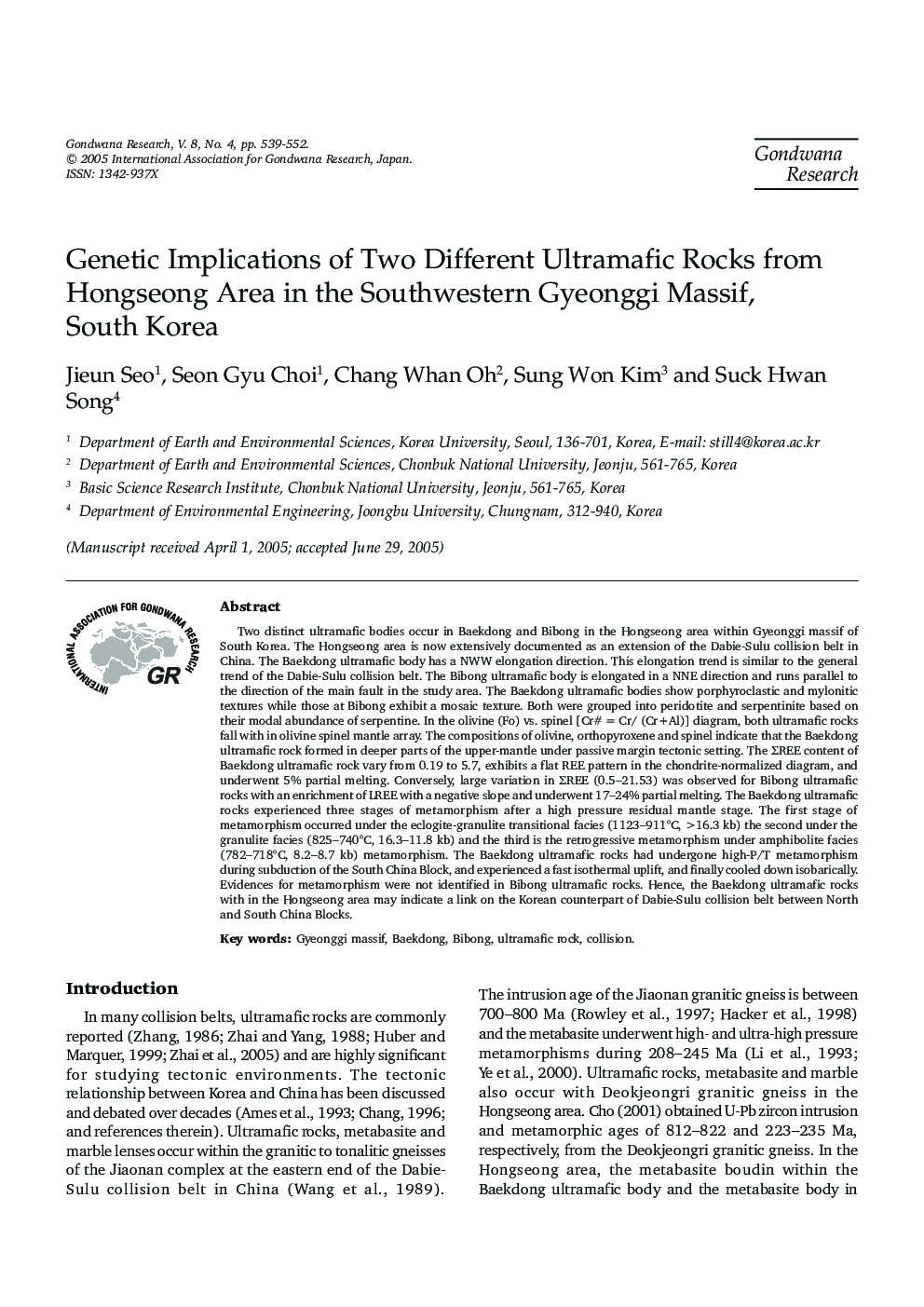| کد مقاله | کد نشریه | سال انتشار | مقاله انگلیسی | نسخه تمام متن |
|---|---|---|---|---|
| 9534730 | 1356421 | 2005 | 14 صفحه PDF | دانلود رایگان |
عنوان انگلیسی مقاله ISI
Genetic Implications of Two Different Ultramafic Rocks from Hongseong Area in the Southwestern Gyeonggi Massif, South Korea
دانلود مقاله + سفارش ترجمه
دانلود مقاله ISI انگلیسی
رایگان برای ایرانیان
موضوعات مرتبط
مهندسی و علوم پایه
علوم زمین و سیارات
زمین شناسی
پیش نمایش صفحه اول مقاله

چکیده انگلیسی
Two distinct ultramafic bodies occur in Baekdong and Bibong in the Hongseong area within Gyeonggi massif of South Korea. The Hongseong area is now extensively documented as an extension of the Dabie-Sulu collision belt in China. The Baekdong ultramafic body has a NWW elongation direction. This elongation trend is similar to the general trend of the Dabie-Sulu collision belt. The Bibong ultramafic body is elongated in a NNE direction and runs parallel to the direction of the main fault in the study area. The Baekdong ultramafic bodies show porphyroclastic and mylonitic textures while those at Bibong exhibit a mosaic texture. Both were grouped into peridotite and serpentinite based on their modal abundance of serpentine. In the olivine (Fo) vs. spinel [Cr# = Cr/ (Cr+Al)] diagram, both ultramafic rocks fall with in olivine spinel mantle array. The compositions of olivine, orthopyroxene and spinel indicate that the Baekdong ultramafic rock formed in deeper parts of the upper-mantle under passive margin tectonic setting. The SREE content of Baekdong ultramafic rock vary from 0.19 to 5.7, exhibits a flat REE pattern in the chondrite-normalized diagram, and underwent 5% partial melting. Conversely, large variation in SREE (0.5 21.53) was observed for Bibong ultramafic rocks with an enrichment of LREE with a negative slope and underwent 17 24% partial melting. The Baekdong ultramafic rocks experienced three stages of metamorphism after a high pressure residual mantle stage. The first stage of metamorphism occurred under the eclogite-granulite transitional facies (1123 911°C, >16.3 kb) the second under the granulite facies (825 740°C, 16.3 11.8 kb) and the third is the retrogressive metamorphism under amphibolite facies (782 718°C, 8.2 8.7 kb) metamorphism. The Baekdong ultramafic rocks had undergone high-P/T metamorphism during subduction of the South China Block, and experienced a fast isothermal uplift, and finally cooled down isobarically. Evidences for metamorphism were not identified in Bibong ultramafic rocks. Hence, the Baekdong ultramafic rocks with in the Hongseong area may indicate a link on the Korean counterpart of Dabie-Sulu collision belt between North and South China Blocks.
ناشر
Database: Elsevier - ScienceDirect (ساینس دایرکت)
Journal: Gondwana Research - Volume 8, Issue 4, October 2005, Pages 539-552
Journal: Gondwana Research - Volume 8, Issue 4, October 2005, Pages 539-552
نویسندگان
Jieun Seo, Seon Gyu Choi, Chang Whan Oh, Sung Won Kim, Suck Hwan Song,